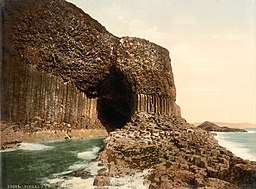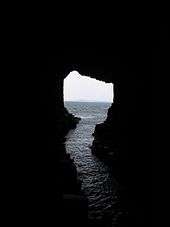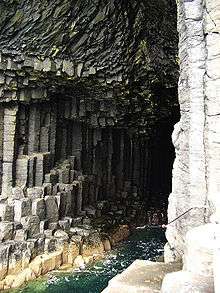Fingal's Cave
Fingal's Cave is a sea cave on the uninhabited island of Staffa, in the Inner Hebrides of Scotland, known for its natural acoustics. The National Trust for Scotland owns the cave as part of a national nature reserve.[1] It became known as Fingal's Cave after the eponymous hero of an epic poem by 18th-century Scots poet-historian James Macpherson.
| Fingal's Cave | |
|---|---|
| An Uaimh Bhinn | |
 Entrance to Fingal's Cave, 1900 | |
| Location | Staffa, Scotland |
| Discovery | 1772 |
| Geology | Paleocene basalt flow |
| Entrances | One |
| Hazards | Partially filled by the sea, slippery rocks |
| Access | Public |
Formation


Fingal's Cave is formed entirely from hexagonally jointed basalt columns within a Paleocene lava flow,[2] similar in structure to the Giant's Causeway in Northern Ireland and those of nearby Ulva.
In all these cases, cooling on the upper and lower surfaces of the solidified lava resulted in contraction and fracturing, starting in a blocky tetragonal pattern and transitioning to a regular hexagonal fracture pattern with fractures perpendicular to the cooling surfaces.[3] As cooling continued these cracks gradually extended toward the centre of the flow, forming the long hexagonal columns we see in the wave-eroded cross-section today. Similar hexagonal fracture patterns are found in desiccation cracks in mud where contraction is due to loss of water instead of cooling.[4]
History
Part of the Ulva estate of the Clan MacQuarrie from an early date until 1777,[5] the cave was brought to the attention of the English-speaking world by 18th-century naturalist Sir Joseph Banks in 1772.[6][7]
It became known as Fingal's Cave after the eponymous hero of an epic poem by 18th century Scots poet-historian James Macpherson. It formed part of his Ossian cycle of poems claimed to have been based on old Scottish Gaelic poems. In Irish mythology, the hero Fingal is known as Fionn mac Cumhaill, and it is suggested that Macpherson rendered the name as Fingal (meaning "white stranger"[8]) through a misapprehension of the name which in old Gaelic would appear as Finn.[9] The legend of the Giant's Causeway has Fionn or Finn building the causeway between Ireland and Scotland.[10]
Sightseeing
The cave has a large arched entrance and is filled by the sea. Several sightseeing cruises organised from April to September by local companies pass the entrance to the cave.[11][6] In calm conditions, one can land at the island's landing place (as some of these cruises permit) and walk the short distance to the cave, where a row of fractured columns forms a walkway just above high-water level permitting exploration on foot.[12] From the inside, the entrance seems to frame the island of Iona across the water.[11]
In art and literature

Romantic composer Felix Mendelssohn visited in 1829 and wrote an overture, The Hebrides, Op. 26, (also known as Fingal's Cave overture), inspired by the weird echoes in the cave.[6][13] Mendelssohn's overture popularized the cave as a tourist destination.[6][7] Other famous 19th-century visitors included author Jules Verne, who used it in his book Le Rayon Vert (The Green Ray), and mentions it in the novels Journey to the Center of the Earth and The Mysterious Island; poets William Wordsworth, John Keats, and Alfred, Lord Tennyson;[1] and Romantic artist J. M. W. Turner, who painted Staffa, Fingal's Cave in 1832.[14] Queen Victoria also made the trip.[1][6]
The 19th century Austro-Hungarian guitarist and composer Johann Kaspar Mertz included a piece entitled Fingals-Höhle in his set of character pieces for guitar Bardenklänge.
The playwright August Strindberg also set scenes from his play A Dream Play in a place called "Fingal's Grotta". Scots novelist Sir Walter Scott described Fingal's Cave as "one of the most extraordinary places I ever beheld. It exceeded, in my mind, every description I had heard of it… composed entirely of basaltic pillars as high as the roof of a cathedral, and running deep into the rock, eternally swept by a deep and swelling sea, and paved, as it were, with ruddy marble, [it] baffles all description."[12]
Artist Matthew Barney used the cave along with the Giant's Causeway for the opening and closing scenes of his art film, Cremaster 3. In 2008, the video artist Richard Ashrowan spent several days recording the interior of Fingal's Cave for an exhibition at the Foksal Gallery in Poland.[15]
One of Pink Floyd's early songs bears this location's name. This instrumental was written for the film Zabriskie Point but not used.[16]
Lloyd House at Caltech has a mural representing Fingal's Cave.[17] The hallway that features this mural also houses a wooden statue named Fingal, which is among the oldest heirlooms at the institute.
Scottish Celtic rock band Wolfstone recorded an instrumental titled Fingal's Cave on their 1999 album Seven.
The Alistair MacLean novel-based movie, When Eight Bells Toll starring Anthony Hopkins was filmed there.[18]
It is possible that the township of Fingal, Tasmania was named after the cave in MacPherson's honour.
Dimensions
Notes
- "National Trust for Scotland: Fingal's Cave". Archived from the original on 2006-06-19. Retrieved 2006-06-02.
- Bell, B.R. and Jolley, D.W. (1997) "Application of palynological data to the chronology of the Palaeogene lava fields of the British Province: implications for magmatic stratigraphy". Journal of the Geological Society. London. Vol. 154, pp. 701–708.
- Atilla Aydin and James M. Degraff (1988) "Evolution of Polygonal Fracture Patterns in Lava Flows," Science 29 January 1988: 239 (4839), 471-476.
- Lucas Goehring, L. Mahadevan, and Stephen W. Morris (2009) "Nonequilibrium scale selection mechanism for columnar jointing". PNAS 2009 106 (2) 387-392
- Haswell-Smith (2004) p. 124
- "Show Caves of the World". Archived from the original on 2006-05-25. Retrieved 2006-06-02.
- Caves and Caving in the UK
- Behind the Name: View Name: Fingal
- Notes to the first edition Archived 2013-10-16 at the Wayback Machine
- Formation of basalt columns / pseudocrystals Archived 2007-11-07 at the Wayback Machine
- Staffa (Fingal's Cave) and the Treshnish Islands The Internet Guide to Scotland
- Gordon Grant Tours: Fingal's Cave
- Galveston Symphony Program Notes: Mendelssohn Archived May 19, 2006, at the Wayback Machine
- The Art Archive, JM Turner
- Blue Flora Celtica. Galeria Foksal. Retrieved 28 May 2020.
- "Unreleased Pink Floyd material" The Pink Floyd Hyperbase. Retrieved 3 August 2008.
- Lloyd House alley list Archived 2009-02-28 at the Wayback Machine. Retrieved 19 October 2009.
- When Eight Bells Toll - Fingals Cave, Staffa
- Wood-Nuttall Encyclopaedia, 1907
- National Public Radio
References
- Haswell-Smith, Hamish (2004). The Scottish Islands. Edinburgh: Canongate. ISBN 978-1-84195-454-7.
External links
| Wikimedia Commons has media related to Fingal's Cave. |